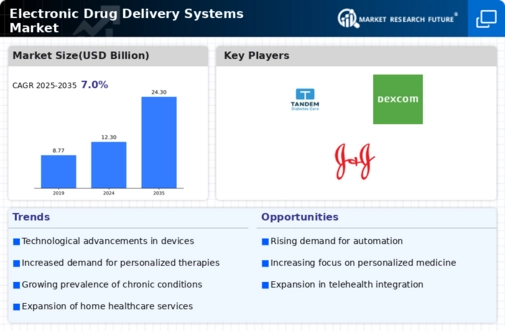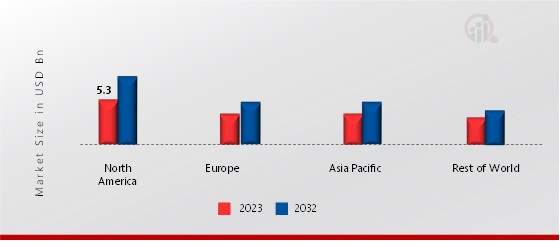-
EXECUTIVE SUMMARY
-
MARKET INTRODUCTION
-
Definition
-
Scope of the Study
- Research Objective
- Assumptions
- Limitations
-
RESEARCH METHODOLOGY
-
Overview
-
Data Mining
-
Secondary Research
-
Primary Research
- Primary Interviews and Information Gathering Process
- Breakdown
-
of Primary Respondents
-
Forecasting Model
-
Market Size Estimation
- Bottom-Up Approach
- Top-Down Approach
-
Data Triangulation
-
Validation
-
MARKET DYNAMICS
-
Overview
-
Drivers
-
Restraints
-
Opportunities
-
MARKET FACTOR ANALYSIS
-
Value Chain Analysis
-
Porter’s Five Forces Analysis
- Bargaining
-
Power of Suppliers
-
Bargaining Power of Buyers
- Threat of
-
New Entrants
-
Threat of Substitutes
- Intensity of Rivalry
-
COVID-19 Impact Analysis
- Market Impact Analysis
-
Regional Impact
-
Opportunity and Threat Analysis
-
GLOBAL ELECTRONIC
-
DRUG DELIVERY SYSTEMS MARKET, BY PRODUCT TYPE
-
Overview
-
Wearable
-
Infusion Pumps
-
Auto Injectors
-
Injection Pens
-
Inhalers
-
GLOBAL ELECTRONIC DRUG DELIVERY SYSTEMS MARKET, BY APPLICATION
-
Overview
-
Diabetes
-
Cardiovascular Disease
-
Respiratory Disorders
-
Multiple Sclerosis
-
Others
-
GLOBAL ELECTRONIC DRUG DELIVERY
-
SYSTEMS MARKET, BY DISTRIBUTION CHANNEL
-
Overview
-
Hospital Pharmacies
-
Retail Pharmacies
-
Online Pharmacies
-
GLOBAL ELECTRONIC DRUG
-
DELIVERY SYSTEMS MARKET, BY REGION
-
Overview
-
North America
- US
- Canada
-
Europe
- Germany
-
France
-
UK
- Italy
- Spain
- Rest of Europe
-
Asia-Pacific
- China
- India
- Japan
-
South Korea
-
Australia
- Rest of Asia-Pacific
-
Rest
-
of the World
-
Middle East
- Africa
- Latin America
-
COMPETITIVE LANDSCAPE
-
Overview
-
Competitive Analysis
-
Market Share Analysis
-
Major Growth Strategy in the Global Electronic
-
Drug Delivery Systems Market,
-
Competitive Benchmarking
-
Leading
-
Players in Terms of Number of Developments in the Global Electronic Drug Delivery
-
Systems Market,
-
Key Developments and Growth Strategies
- New
-
Product Launch/Service Deployment
-
Merger & Acquisitions
-
Joint Ventures
-
Major Players Financial Matrix
- Sales &
-
Operating Income, 2023
-
Major Players R&D Expenditure. 2023
-
COMPANY PROFILES
-
Insulet Corporation
- Company Overview
- Financial Overview
- Products Offered
- Key Developments
- SWOT Analysis
- Key Strategies
-
Medtronic plc
- Company Overview
- Financial Overview
- Products
-
Offered
-
Key Developments
- SWOT Analysis
- Key
-
Strategies
-
Tandem Diabetes Care, Inc.
- Company Overview
- Financial Overview
- Products Offered
- Key Developments
- SWOT Analysis
- Key Strategies
-
Dexcom, Inc.
-
Company Overview
-
Financial Overview
- Products Offered
- Key Developments
- SWOT Analysis
- Key Strategies
-
Abbott Laboratories
- Company Overview
- Financial
-
Overview
-
Products Offered
- Key Developments
-
SWOT Analysis
-
Key Strategies
-
Eli Lilly and Company
-
Company Overview
-
Financial Overview
- Products Offered
- Key Developments
- SWOT Analysis
- Key Strategies
-
Novo Nordisk A/S
- Company Overview
- Financial Overview
- Products Offered
- Key Developments
- SWOT Analysis
- Key Strategies
-
Roche Holding AG
- Company Overview
- Financial Overview
- Products Offered
- Key Developments
- SWOT Analysis
- Key Strategies
-
Johnson & Johnson
- Company Overview
- Financial Overview
- Products
-
Offered
-
Key Developments
- SWOT Analysis
- Key
-
Strategies
-
Amgen Inc.
- Company Overview
- Financial
-
Overview
-
Products Offered
- Key Developments
-
SWOT Analysis
-
Key Strategies
-
APPENDIX
-
References
-
Related Reports
-
DELIVERY SYSTEMS MARKET, SYNOPSIS, 2019-2032
-
DELIVERY SYSTEMS MARKET, ESTIMATES & FORECAST, 2019-2032 (USD BILLION)
-
GLOBAL ELECTRONIC DRUG DELIVERY SYSTEMS MARKET, BY PRODUCT TYPE, 2019-2032 (USD
-
BILLION)
-
2032 (USD BILLION)
-
BY DISTRIBUTION CHANNEL, 2019-2032 (USD BILLION)
-
DRUG DELIVERY SYSTEMS MARKET, BY PRODUCT TYPE, 2019-2032 (USD BILLION)
-
NORTH AMERICA: ELECTRONIC DRUG DELIVERY SYSTEMS MARKET, BY APPLICATION, 2019-2032
-
(USD BILLION)
-
BY DISTRIBUTION CHANNEL, 2019-2032 (USD BILLION)
-
DELIVERY SYSTEMS MARKET, BY PRODUCT TYPE, 2019-2032 (USD BILLION)
-
US: ELECTRONIC DRUG DELIVERY SYSTEMS MARKET, BY APPLICATION, 2019-2032 (USD BILLION)
-
2032 (USD BILLION)
-
BY PRODUCT TYPE, 2019-2032 (USD BILLION)
-
SYSTEMS MARKET, BY APPLICATION, 2019-2032 (USD BILLION)
-
DRUG DELIVERY SYSTEMS MARKET, BY DISTRIBUTION CHANNEL, 2019-2032 (USD BILLION)
-
(USD BILLION)
-
2032 (USD BILLION)
-
BY DISTRIBUTION CHANNEL, 2019-2032 (USD BILLION)
-
DRUG DELIVERY SYSTEMS MARKET, BY PRODUCT TYPE, 2019-2032 (USD BILLION)
-
GERMANY: ELECTRONIC DRUG DELIVERY SYSTEMS MARKET, BY APPLICATION, 2019-2032 (USD
-
BILLION)
-
CHANNEL, 2019-2032 (USD BILLION)
-
MARKET, BY PRODUCT TYPE, 2019-2032 (USD BILLION)
-
DRUG DELIVERY SYSTEMS MARKET, BY APPLICATION, 2019-2032 (USD BILLION)
-
FRANCE: ELECTRONIC DRUG DELIVERY SYSTEMS MARKET, BY DISTRIBUTION CHANNEL, 2019-2032
-
(USD BILLION)
-
TYPE, 2019-2032 (USD BILLION)
-
MARKET, BY APPLICATION, 2019-2032 (USD BILLION)
-
DRUG DELIVERY SYSTEMS MARKET, BY DISTRIBUTION CHANNEL, 2019-2032 (USD BILLION)
-
(USD BILLION)
-
2032 (USD BILLION)
-
BY DISTRIBUTION CHANNEL, 2019-2032 (USD BILLION)
-
DELIVERY SYSTEMS MARKET, BY PRODUCT TYPE, 2019-2032 (USD BILLION)
-
UK: ELECTRONIC DRUG DELIVERY SYSTEMS MARKET, BY APPLICATION, 2019-2032 (USD BILLION)
-
2032 (USD BILLION)
-
MARKET, BY PRODUCT TYPE, 2019-2032 (USD BILLION)
-
DRUG DELIVERY SYSTEMS MARKET, BY APPLICATION, 2019-2032 (USD BILLION)
-
REST OF EUROPE: ELECTRONIC DRUG DELIVERY SYSTEMS MARKET, BY DISTRIBUTION CHANNEL,
-
2032 (USD BILLION)
-
MARKET, BY PRODUCT TYPE, 2019-2032 (USD BILLION)
-
DRUG DELIVERY SYSTEMS MARKET, BY APPLICATION, 2019-2032 (USD BILLION)
-
ASIA-PACIFIC: ELECTRONIC DRUG DELIVERY SYSTEMS MARKET, BY DISTRIBUTION CHANNEL,
-
2032 (USD BILLION)
-
BY PRODUCT TYPE, 2019-2032 (USD BILLION)
-
SYSTEMS MARKET, BY APPLICATION, 2019-2032 (USD BILLION)
-
DRUG DELIVERY SYSTEMS MARKET, BY DISTRIBUTION CHANNEL, 2019-2032 (USD BILLION)
-
(USD BILLION)
-
2032 (USD BILLION)
-
BY DISTRIBUTION CHANNEL, 2019-2032 (USD BILLION)
-
DRUG DELIVERY SYSTEMS MARKET, BY PRODUCT TYPE, 2019-2032 (USD BILLION)
-
INDIA: ELECTRONIC DRUG DELIVERY SYSTEMS MARKET, BY APPLICATION, 2019-2032 (USD
-
BILLION)
-
CHANNEL, 2019-2032 (USD BILLION)
-
SYSTEMS MARKET, BY PRODUCT TYPE, 2019-2032 (USD BILLION)
-
ELECTRONIC DRUG DELIVERY SYSTEMS MARKET, BY APPLICATION, 2019-2032 (USD BILLION)
-
2032 (USD BILLION)
-
MARKET, BY PRODUCT TYPE, 2019-2032 (USD BILLION)
-
DRUG DELIVERY SYSTEMS MARKET, BY APPLICATION, 2019-2032 (USD BILLION)
-
SOUTH KOREA: ELECTRONIC DRUG DELIVERY SYSTEMS MARKET, BY DISTRIBUTION CHANNEL,
-
2032 (USD BILLION)
-
SYSTEMS MARKET, BY PRODUCT TYPE, 2019-2032 (USD BILLION)
-
ASIA-PACIFIC: ELECTRONIC DRUG DELIVERY SYSTEMS MARKET, BY APPLICATION, 2019-2032
-
(USD BILLION)
-
MARKET, BY DISTRIBUTION CHANNEL, 2019-2032 (USD BILLION)
-
WORLD: ELECTRONIC DRUG DELIVERY SYSTEMS MARKET, BY PRODUCT TYPE, 2019-2032 (USD
-
BILLION)
-
BY APPLICATION, 2019-2032 (USD BILLION)
-
DRUG DELIVERY SYSTEMS MARKET, BY DISTRIBUTION CHANNEL, 2019-2032 (USD BILLION)
-
2032 (USD BILLION)
-
MARKET, BY APPLICATION, 2019-2032 (USD BILLION)
-
DRUG DELIVERY SYSTEMS MARKET, BY DISTRIBUTION CHANNEL, 2019-2032 (USD BILLION)
-
(USD BILLION)
-
APPLICATION, 2019-2032 (USD BILLION)
-
SYSTEMS MARKET, BY DISTRIBUTION CHANNEL, 2019-2032 (USD BILLION)
-
AMERICA: ELECTRONIC DRUG DELIVERY SYSTEMS MARKET, BY PRODUCT TYPE, 2019-2032 (USD
-
BILLION)
-
APPLICATION, 2019-2032 (USD BILLION)
-
DELIVERY SYSTEMS MARKET, BY DISTRIBUTION CHANNEL, 2019-2032 (USD BILLION)
-
LIST
-
OF FIGURES
-
GLOBAL ELECTRONIC DRUG DELIVERY SYSTEMS MARKET
-
THE GLOBAL ELECTRONIC DRUG DELIVERY SYSTEMS MARKET
-
DRUG DELIVERY SYSTEMS MARKET, SHARE (%), BY PRODUCT TYPE, 2023
-
ELECTRONIC DRUG DELIVERY SYSTEMS MARKET, SHARE (%), BY APPLICATION, 2023
-
GLOBAL ELECTRONIC DRUG DELIVERY SYSTEMS MARKET, SHARE (%), BY DISTRIBUTION CHANNEL,
-
REGION, 2023
-
SHARE (%), BY REGION, 2023
-
MARKET, SHARE (%), BY REGION, 2023
-
DELIVERY SYSTEMS MARKET, SHARE (%), BY REGION, 2023
-
ELECTRONIC DRUG DELIVERY SYSTEMS MARKET, SHARE (%), BY REGION, 2023
-
GLOBAL ELECTRONIC DRUG DELIVERY SYSTEMS MARKET: COMPANY SHARE ANALYSIS, 2023
-
INSULET CORPORATION: SWOT ANALYSIS
-
SNAPSHOT
-
CARE, INC.: FINANCIAL OVERVIEW SNAPSHOT
-
SWOT ANALYSIS
-
DEXCOM, INC.: SWOT ANALYSIS
-
SNAPSHOT
-
AND COMPANY: FINANCIAL OVERVIEW SNAPSHOT
-
ANALYSIS
-
NOVO NORDISK A/S: SWOT ANALYSIS
-
SNAPSHOT
-
& JOHNSON: FINANCIAL OVERVIEW SNAPSHOT
-
SWOT ANALYSIS
-
AMGEN INC.: SWOT ANALYSIS





